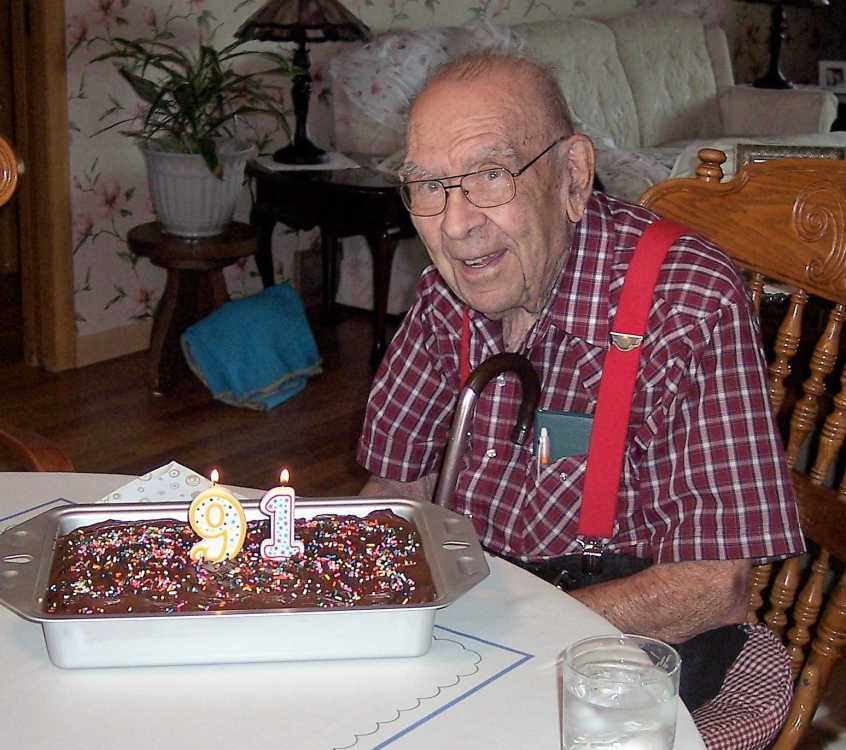Ken Martin remembers the 1935 Republican River flood
Monday, July 31, 2017

Ken Martin
'Ken Martin has been a resident of McCook for a number of years. Now living at Hillcrest, Ken has found an outlet for extra spare time and has turned out a number of interesting monologues (for the family, says Ken). Recently he has put a collection of these writings together, under the title of “A Good Day for Woolgathering on a Summer’s Day”, an unpublished manuscript, which Ken agreed to share with me and my readers. It covers a lot of topics — the Depression, the flood, and Ken’s service in New Guinea and the South Pacific during World War II. The following story covers Ken’s recollection of the 1935 Republican River flood of Southwest Nebraska.
Four or five days previous to the flood we had had a lot of rain. The river and creeks were running bank to bank and there was some minor flooding in the lowlands. As these were the days of the Dust Bowl, my brothers and I found this to be very exciting and we spent a lot of time exploring our wet, muddy world!
At the time of the 1935 Republican River flood we lived on a small family farm about 1 ˝ miles west of Edison, Nebraska. Our family consisted of parents, Florence and Merlin (Pat) Martin, myself, 13 years old, Ward, 12, Mark 10 and Norma, 7. Our house was situated on “2nd bottom”, which was located on higher ground overlooking the valley. But Grandma and Grandpa Martin, whose house was on the same farm, were located on “1st bottom.” At the flood’s crest, the water reached to within 1 or 2 inches from the floor of our house, but it was about 5 feet deep in our grandparents’ house. Parts of a neighbor’s buildings lodged in some trees near the west side of their house, which seemed o divert the current, thus preventing structural damage, though most of the contents were destroyed by the stinking water.
On the afternoon of May 31, Grandpa came home from town and told us that he had heard that a 10-foot wall of water had passed McCook, 30 miles upstream, and was coming down the valley, bluff to bluff. The “rumor” of course was considered to be preposterous, as nothing like that had ever happened before. Never-the-less, it was determined that it might be best if Grandma and Grandpa spent the night at our house, since it was located on higher, safer ground. (After the fact, we heard that an old Indian had told the early white settlers that he remembered a bluff-to-bluff flood in the Republican Valley.)
Sometime after dark, all of us youngsters went to bed, but shortly thereafter were awakened and urgently ordered to get dressed. Sixty years later I can still remember the anxiety in our mother’s voice as she told me, in answer to my questions, that it was 11 p.m. and that the water was from the river and not from the creek that bisected our farm.
The decision to go to higher ground had been made, and we all set out on foot, as there was no other way to get out. Our house was situated on a small knoll, and the water to the north was running about 2 to 2 ˝ feet deep, in effect leaving the house on a little island. We were fortunate that, by the time we started wading out, the flood had reached to within a few inches of its crest. To keep in touch, we carried a kerosene lantern and a 2-cell flashlight. Occasional brilliant flashes of lightning illuminated the entire scene of the expanse of water running in the otherwise black , black night. It seems strange now, but neither my brothers nor I felt any fear for our own safety that night. Dad carried little sister, Norma, and it became the duty of the boys to help Grandma and our mother through the difficult water. Neither of them could swim. We accepted this responsibility as the natural thing to do. My best estimate is that we waded about one-third of a mile before reaching solid ground.
In 1935, there were very few short-wave radios and the flood waters had severely damaged most telephone lines in Southwest Nebraska. Even so, by the afternoon of June 1 we had received the disturbing news that our other grandparents, Nora and Frank Ferguson, at Benkelman, had been seen riding the flood waters of the South Republican on the roof of their house. This was all the news that we were able to obtain as to their welfare, and it was not until June 3 that we were informed that they had been rescued from a tree, after a harrowing ride of some 8 miles, and were safe at the farm of their son, near St. Francis, Kansas.
Grandma Ferguson refused to talk about their experience, saying she wanted to forget; however Grandpa Ferguson told us riveting stories of their experience. As they were drifting down river, their roof raft began to break up. Just as it appeared that their roof raft could no longer hold them up, they were swept under some tree branches, and they were able to seize one, and hang on, with their feet dangling in the water. Grandpa was able to work himself up into the higher branches, and with a great deal of pulling and coaxing, was able to get grandma up there with him. He noted that this was probably the most frightening part of their adventure, as he was not at all sure that grandma was going to be able to hang on, and he had the constant fear that he might lose her.
They stayed in their treetop sanctuary for about 30 hours. after which they were rescued in a floating stock watering tank that had been tied to the shore by a long cable. Their rescuers were able to pole out to their little island to rescue them. Grandpa said that by the time they were rescued their tree was the only one that had not been swept away by the flood waters.
For the rest of their lives Grandpa and Grandma spoke of the Divine Hand that helped rescue them from the flood waters.
In the days, following the flood family members returned to the Ferguson farm, and had a difficult time locating the spot where their home had been situated. All of the buildings, trees, machinery (including automobiles), and farm animals were gone. Even the river channel, which had been located some 200 yards from their house had moved. After some searching, they found a pump rod protruding about 6 inches out of the ground, bent to an angle of 90 degrees, flat with the ground. By this they were able to estimate where the house and buildings had stood, as well as the location of the road, which had run just east of the house.
An adventure of this magnitude leaves a lot of memories, some important some trivial. The 1935 Republican River Flood was certainly a major tragedy. Some 115 people lost their lives, not to mention the great number of livestock that were lost, and damage to land and property. The river channel was changed in most places, and trees were uprooted and washed up in great piles. Crops were planed after the flood, but ironically nearly all of the replanted crops failed because so little rain fell during the rest of the summer.
I have made every effort to tell it the way it happened, but there is no wat that I can convey the emotions and all the results of the event. However, I hope that this little story will proves worthy of remembrance.
Signed,

